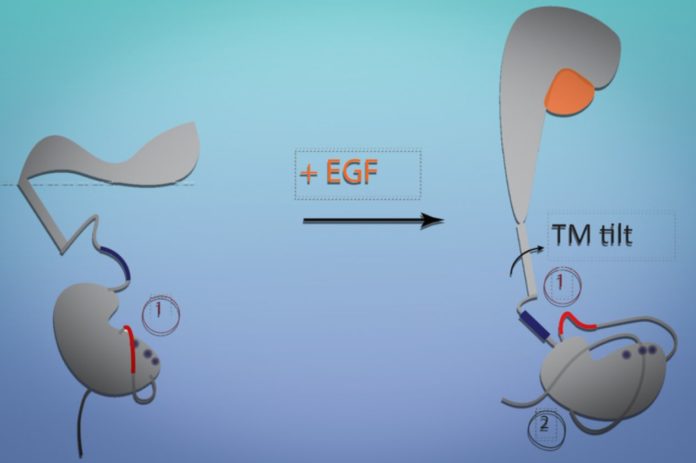Cell surfaces contain receptors that attach to hormones, proteins, and other substances to help cells react to their surroundings. MIT chemists have finally figured out how one of these receptors modifies when it connects to its target and how those modifications cause cells to multiply and proliferate.
The epidermal growth factor receptor (EGFR), which is overexpressed in many cancer types, is the target of various anti-cancer medications. Although these medications frequently have good initial results, cancers may develop a resistance to them. According to Gabriela Schlau-Cohen, an associate professor of chemistry at MIT, a deeper understanding of the mechanism of these receptors may aid researchers in designing drugs that can overcome that resistance.
“Thinking about more general mechanisms to target EGFR is an exciting new direction,” she says as it “gives you a new avenue to think about possible therapies that may not evolve resistance as easily.”
Schlau-Cohen and Bin Zhang, an assistant professor of chemistry and the Pfizer-Laubach Career Development Professor, are the study’s principal authors. It was published in Nature Communications today. Shwetha Srinivasan, an MIT graduate student, and Raju Regmi, a former postdoc at MIT, are the paper’s lead authors.
Shape-altering receptors
One of the many receptors that aid in regulating cell development is the EGF receptor. It is present on the majority of mammalian epithelial cell types that cover body surfaces and line organs, and in addition to EGF, it can react to other types of growth factors. Some cancers, particularly glioblastoma and lung cancer, overexpress the EGF receptor, which can result in unchecked proliferation.
The EGFR spans the cell membrane, like the majority of cell receptors. An intracellular region of the receptor interacts with cellular machinery that regulates growth pathways, a transmembrane section is embedded within the membrane, and an extracellular region of the receptor interacts with its target molecule (also known as a ligand).
The extracellular region of the receptor has been well examined, but the transmembrane and intracellular sections are chaotic and cannot be crystallized, making them challenging to research.
Schlau-Cohen began her quest to understand more about these obscure monuments roughly five years ago. Her team incorporated the proteins into a unique form of self-assembling membrane known as a nanodisc, which resembles a cell membrane. Then, she investigated how the conformation of the receptor changes when it binds to EGF using single molecule FRET (fluorescence resonance energy transfer).
FRET is widely used to determine the smallest distance between two fluorescent molecules. In order to determine the distance between the protein tail and the cell membrane under various conditions, the researchers labeled the nanodisc membrane and the end of the intracellular tail of the protein with two distinct fluorophores.
Surprisingly, the researchers discovered that EGF interaction caused a significant alteration in the receptor’s structure. Most receptor signaling theories involve many transmembrane helices interacting to cause large-scale conformational changes, however the EGF receptor, which only has a single helical section within the membrane, appears to undergo such a shift without interacting with other receptor molecules.
Schlau-Cohen says, “The idea of a single alpha helix being able to transduce such a large conformational rearrangement was really surprising to us.”
Molecular simulation
Schlau-team Cohen’s collaborated with Zhang’s group, which uses computer simulations to study molecular interactions, to find out more about how this shape shift can impact the receptor’s functionality. The molecular dynamics modeling approach can simulate how a molecular system changes over time.
Modeling revealed that the extracellular portion of the receptor stands up vertically when it binds to EGF, whereas when it is unbound, it sits flat against the cell membrane.
When the receptor collapses, it tilts the transmembrane segment and draws the intracellular section closer to the membrane, acting like a hinge shutting.
This prevents the protein’s intracellular portion from interacting with the mechanisms required to initiate cell development. These areas become more accessible when EGF binds to them, aiding in the activation of growth signaling pathways.
Using their model, the researchers also determined that positively charged amino acids in the intracellular segment, close to the cell membrane, are crucial to these interactions. When the researchers changed these charged amino acids to neutral ones, ligand binding ceased to activate the receptor.
The simulation and experiment exhibit a pleasing uniformity, claims Zhang.
“With the molecular dynamics simulations, we can figure out what are the amino acids that are essential for the coupling, and quantify the role of different amino acids. Then Gabriela showed that those predictions turned out to be correct.”
In addition, the researchers discovered that cetuximab, a medication that interacts with the EGF receptor, inhibits this conformational change.
Patients with head and neck cancer or colorectal cancer have shown some success with cetuximab treatment, although cancers can develop resistance to it.
Researchers claim that by understanding the process by which EGFR reacts to various ligands, they may be able to develop medications that are less likely to cause resistance.
Image Credit: MIT
You were reading: Shape-shifting Receptor Influencing Cell Growth Leads To New Cancer Drugs
